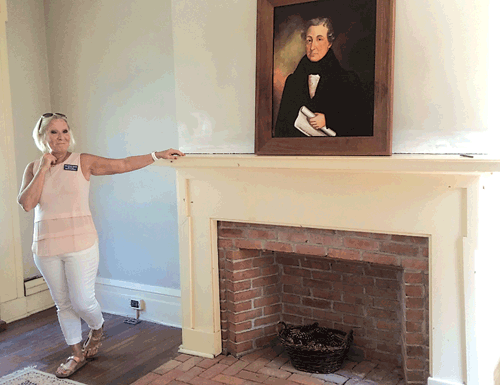THE AKIMA PINSIWA AWIIKI
 On a balmy September afternoon, locals flocked by the dozens for a little fun and historical information at 5705 Bluffton Road in Waynedale.
On a balmy September afternoon, locals flocked by the dozens for a little fun and historical information at 5705 Bluffton Road in Waynedale.
As part of the Fort Wayne History Center’s summer-long series of events highlighting the city’s prominent place in national history.
Admission for the event was $7 for adult, $5 for seniors and youngsters ages 3-17. History Center members were given free entry.
Visitors began their afternoon watching a demonstration of cattail matting on the sturdy back porch of the Akima Pinsiwa Awiiki otherwise known as Chief Richardville’s house.
Several women split the long, thin grasses with their fingernails. Then, hung the pieces from a long piece of twine strung between two of the porch’s columns.
Native American Indians in Chief Richardville’s time used the woven fiber for everything from belts and caps, to dolls and even military weapons.
Chief Richardville, also known as Jean Baptiste de Richardville, was born in 1761 in the Miami Village of Kekionga-now known as present day Fort Wayne. He was the last akima (civil chief or leader) of the Miami people. He was a fur trader, who –along with his mother- owned and controlled an important portage (or small waterway) connecting the Maumee River to the Little River (today known as the Little Wabash). Local traders needed to use the passage to move from local waterways to the Wabash River, then the Mississippi River, and finally to New Orleans and other points to the South.
His control and ownership of the portage gave him considerable wealth. Much of his fortune was made by providing horses, clothing, and canoes along the portage. He eventually came to be considered the wealthiest man in Indiana.
When he signed the Treaty of The Mississinas in 1826, he was given $600 by the United States government for the construction of a house. After kicking in $1,600 of his own money, the first Greek Revival-style home in Northeastern Indiana was completed in 1827.
Still standing tall today in Waynedale, the home’s exterior doesn’t look any of its 189 years. Visitors on Saturday were first lead into the parlor, the formal room, where the Chief likely had funerals, entertained guests and other local dignitaries. The squawl, brick edifice sits today on Bluffton Road, just south of Old Trail Road. With a red brick exterior, brick chimneys, white trim and green shutters, it’s not easy to tell the rich history inside.
Tours were led by Barb Ehinger, Education Coordinator for the History Center, also a former history teacher for Southwest Allen County Schools.
She led tourists to the living room next, a room dominated by a brick-framed fireplace and a large portrait of Chief Richardville himself, dressed in French period clothing. Most rooms in the home still had their original, yellow poplar floors, with hand-hewn nails still visible throughout the narrow floorboards.
Tours concluded with a visit up the narrow, rug-covered staircase to the family’s bedroom and two cramped, low-ceiling servant’s quarters. Servants likely shuffled from their tiny room, down a small staircase, to the home’s kitchen, in order to work and service the family and guests.
Chief Richardville died in 1841, one of the richest men in the Midwest. His home was acquired in 1991 by the Allen County-Fort Wayne Historical Society. The United States government officially declared it a National Historic Landmark in 2012. It is, in fact, the only Treaty House (of the once thousands in existence) that is still standing in the United States.
- Fox Island County Park Reopens After 2 Years - June 21, 2024
- New Mural By Local Artist Adorns Community - June 7, 2024
- Community Ready To Honor Veterans With Annual Parade - May 24, 2024


